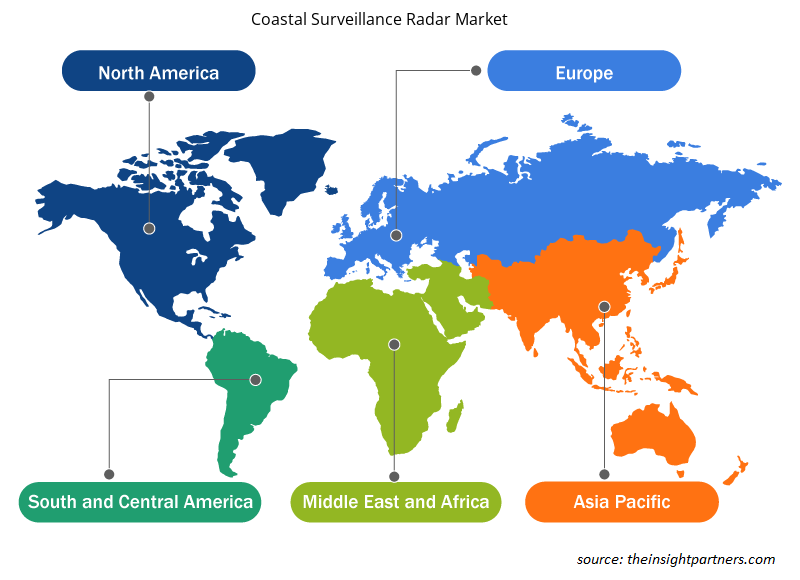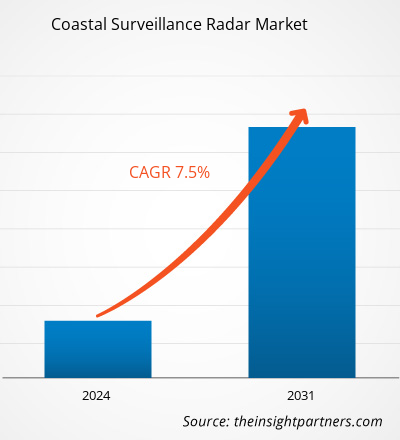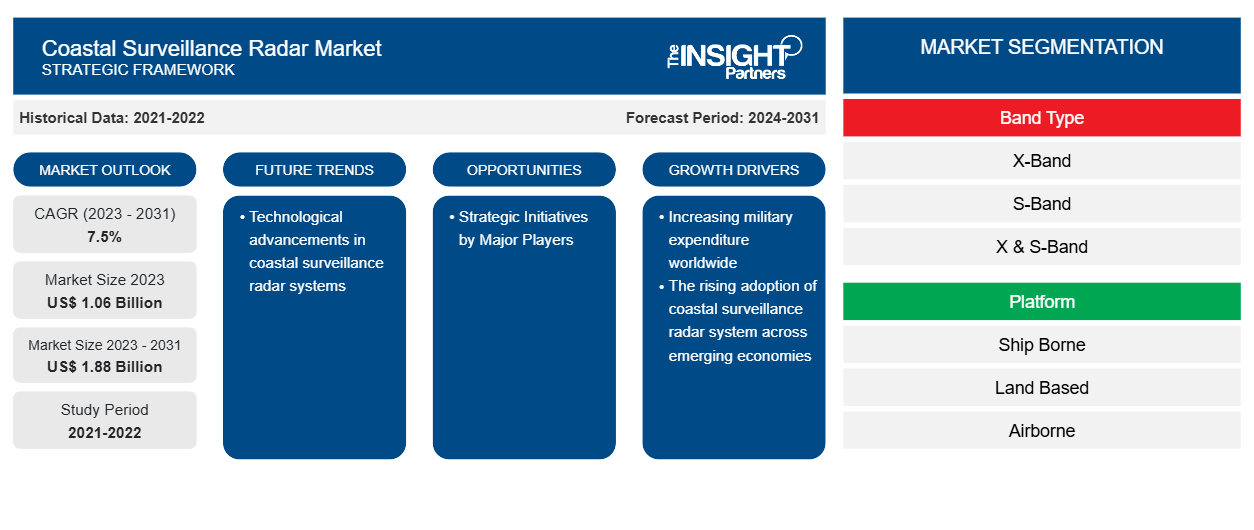من المتوقع أن يصل حجم سوق رادار المراقبة الساحلية إلى 1.88 مليار دولار أمريكي بحلول عام 2031 من 1.06 مليار دولار أمريكي في عام 2023. ومن المتوقع أن يسجل السوق معدل نمو سنوي مركب بنسبة 7.5٪ خلال الفترة 2023-2031. ومن المرجح أن تظل التطورات التكنولوجية في أنظمة رادار المراقبة الساحلية اتجاهًا رئيسيًا في السوق.
تحليل سوق رادار مراقبة السواحل
تعد شركة Elbit Systems Ltd، ومجموعة Thales Group، وIsrael Aerospace Industries، وHensoldt AG، وTerma A/S، من بين اللاعبين الرئيسيين في السوق العالمية لرادارات المراقبة الساحلية. تشارك هذه الشركات في تطوير أنظمة قوية بما في ذلك رادارات X-band وS-band وX وS-band للمستخدمين النهائيين المختلفين. بالإضافة إلى ذلك، تتمتع هذه الشركات أيضًا بعدد كبير من العقود لراداراتها من مختلف القوات البحرية وخفر السواحل وشركات النفط والغاز، فضلاً عن الموانئ. توقع الشركات اتفاقيات طويلة الأجل مع المستخدمين النهائيين لدعم توريد منتجات رادار المراقبة الساحلية، مما يمكن الشركات من توليد الإيرادات عامًا بعد عام.
نظرة عامة على سوق رادار مراقبة السواحل
تشمل الجهات المعنية الرئيسية في النظام البيئي لسوق رادار المراقبة الساحلية العالمية مصنعي المكونات ومُدمجي الأنظمة والمستخدمين النهائيين من بين آخرين. يتكون رادار نظام المراقبة الساحلية من مكونات مختلفة يتم شراؤها من قبل مصنعي النظام من قاعدة ضخمة من مصنعي المكونات. يوفر مصنعو المكونات هؤلاء الأجزاء الأساسية للاعبين في رادار المراقبة الساحلية العالمية. مُدمجو الأنظمة هم الشركات التي تعمل في تصنيع أنظمة رادار المراقبة النهائية بعد دمج كل مكون. يشمل المستخدم النهائي لسوق رادار المراقبة الساحلية العالمية كل من الهيئات الحاكمة والمنظمات الخاصة التي تمارس أعمالها عبر الساحل. تعتمد شركات النفط والغاز المتعددة الجنسيات الموجودة على الساحل بشكل كبير على رادارات المراقبة لضمان السلامة والأمان في عملياتها وأصولها. من ناحية أخرى، فإن ارتفاع الإنفاق العسكري من قبل الدول المتقدمة والنامية واستثماراتها المتزايدة لضمان الحدود البرية والساحلية من عوامل مثل الاتجار بالمخدرات والإرهاب والمهاجرين غير المسجلين من بين أمور أخرى يدفع أيضًا إلى التبني العالي لرادار المراقبة الساحلية من قبل الهيئات الحكومية.
قم بتخصيص هذا التقرير ليناسب متطلباتك
ستحصل على تخصيص لأي تقرير - مجانًا - بما في ذلك أجزاء من هذا التقرير، أو تحليل على مستوى الدولة، وحزمة بيانات Excel، بالإضافة إلى الاستفادة من العروض والخصومات الرائعة للشركات الناشئة والجامعات
-
احصل على أهم اتجاهات السوق الرئيسية لهذا التقرير.ستتضمن هذه العينة المجانية تحليلاً للبيانات، بدءًا من اتجاهات السوق وحتى التقديرات والتوقعات.
محركات وفرص سوق رادار مراقبة السواحل
اعتماد متزايد على نظام رادار مراقبة السواحل في الاقتصادات الناشئة
ومن المتوقع أن يؤدي ارتفاع التهديدات الحدودية عبر الاقتصادات الناشئة مثل الصين والهند وتايوان وكوريا الجنوبية وروسيا وأوكرانيا وإسرائيل وفلسطين وإيران إلى تعزيز تبني أنظمة الرادار لمراقبة السواحل. ونظرًا لارتفاع وتيرة الحروب البحرية والتمردات في المحيطات، أصبحت المناطق الساحلية عبر هذه الاقتصادات حيوية بشكل متزايد، ويلعب رادار المراقبة دورًا حاسمًا في اكتشاف التهديدات في الوقت الفعلي. يمكن للقادة الحصول على رؤى قيمة حول تحركات العدو ومحيطه من خلال نشر أنظمة رادار متقدمة على طول الحدود الساحلية، وبالتالي اتخاذ التدابير اللازمة بناءً على البيانات في الوقت الفعلي. هذه الفائدة المتمثلة في جمع البيانات في الوقت الفعلي مع صور واضحة وعالية الدقة هي نقطة الجذب الحاسمة للمستخدمين النهائيين. وبالتالي، وعلى خلفية المعايير الحاسمة، كان سوق رادار المراقبة الساحلية ينمو في جميع أنحاء العالم.
المبادرات الاستراتيجية التي اتخذها اللاعبون الرئيسيون
تتبنى الشركات العاملة في سوق رادار المراقبة الساحلية استراتيجيات النمو العضوي وغير العضوي، مثل الاستثمارات الكبيرة وعروض المنتجات والتوسع العالمي، مما يخلق المزيد من فرص النمو لسوق رادار المراقبة الساحلية العالمية. ومن بين التطورات الرئيسية التي يجب ذكرها:
- في سبتمبر 2022، منحت خفر السواحل الأمريكي عقدًا لشركة L3Harris Technologies Inc لما يصل إلى خمسة رادارات متعددة الأوضاع من طراز AN/APY-11 والتي سيتم تركيبها على طائرات المراقبة طويلة المدى الجديدة C-130J Super Hercules أثناء عملية مهمة Minotaur. العقد الثابت هو لتسليم ثلاثة رادارات متعددة الأوضاع، والتي سيتم تركيبها بواسطة L-3 Communication Integrated Systems في وايكو، تكساس، أثناء المهمة وترقية Block 8.1 للطائرات C-130J الثامنة عشرة والتاسعة عشرة والعشرين في أسطول خفر السواحل.
- في ديسمبر 2022، وقعت شركة LIG Nex1 Co اتفاقية مع القيادة اللوجستية البحرية لمشروع رادار المراقبة البحرية الثاني.
وقد أدت مثل هذه التطورات إلى توليد فرص جديدة لبائعي السوق في مختلف المناطق.
تقرير تحليلي لتجزئة سوق رادار مراقبة السواحل
إن القطاعات الرئيسية التي ساهمت في اشتقاق تحليل سوق رادار المراقبة الساحلية هي نوع النطاق والمنصة والمستخدم النهائي.
- بناءً على نوع النطاق، يتم تقسيم سوق رادار المراقبة الساحلية إلى نطاق X ونطاق S ونطاق X/S وغيرها. احتل قطاع نطاق X حصة سوقية أكبر في عام 2023.
- استنادًا إلى المنصة، يتم تقسيم سوق رادار المراقبة الساحلية إلى رادارات محمولة على السفن، وبريّة، وجوية. احتلت شريحة الجو حصة سوقية أكبر في عام 2023.
- بناءً على المستخدم النهائي، يتم تقسيم سوق رادار المراقبة الساحلية إلى شركات الموانئ والنفط والغاز ووكالات الدوريات البحرية . احتل قطاع وكالات الدوريات البحرية حصة سوقية أكبر في عام 2023.
تحليل حصة سوق رادار المراقبة الساحلية حسب المنطقة الجغرافية
ينقسم النطاق الجغرافي لتقرير سوق رادار المراقبة الساحلية بشكل أساسي إلى خمس مناطق: أمريكا الشمالية وأوروبا وآسيا والمحيط الهادئ والشرق الأوسط وأفريقيا وأمريكا الجنوبية.
سيطرت أمريكا الشمالية على السوق في عام 2023 تليها منطقتي أوروبا وآسيا والمحيط الهادئ. علاوة على ذلك، من المرجح أيضًا أن تشهد منطقة آسيا والمحيط الهادئ أعلى معدل نمو سنوي مركب في السنوات القادمة. استحوذت الولايات المتحدة على أكبر حصة سوقية في سوق رادار المراقبة الساحلية في أمريكا الشمالية. كما تعد الولايات المتحدة دولة متقدمة من الناحية التكنولوجية ولديها إمكانات هائلة لتبني تقنيات جديدة على مر السنين. تتمتع شركات النفط والغاز الموجودة في جميع أنحاء البلاد أيضًا بإمكانيات هائلة لتبني التقنيات لتأمين عملياتها عبر السواحل. وهذا يؤثر بشكل أكبر على اعتماد رادارات المراقبة الساحلية للحد من الأنشطة غير المشروعة أو تقييدها في جميع أنحاء البلاد. تعد Accipiter Radar Technologies Inc و Teledyne FLIR LLC و L3Harris Technologies Inc و Raytheon Technologies Corporation و SSR Engineering من بين اللاعبين العاملين في السوق الأمريكية.
رؤى إقليمية حول سوق رادار مراقبة السواحل
لقد قام المحللون في Insight Partners بشرح الاتجاهات والعوامل الإقليمية المؤثرة على سوق رادار المراقبة الساحلية طوال فترة التنبؤ بشكل شامل. يناقش هذا القسم أيضًا قطاعات سوق رادار المراقبة الساحلية والجغرافيا في جميع أنحاء أمريكا الشمالية وأوروبا ومنطقة آسيا والمحيط الهادئ والشرق الأوسط وأفريقيا وأمريكا الجنوبية والوسطى.

- احصل على البيانات الإقليمية المحددة لسوق رادار مراقبة السواحل
نطاق تقرير سوق رادار المراقبة الساحلية
| سمة التقرير | تفاصيل |
|---|---|
| حجم السوق في عام 2023 | 1.06 مليار دولار أمريكي |
| حجم السوق بحلول عام 2031 | 1.88 مليار دولار أمريكي |
| معدل النمو السنوي المركب العالمي (2023 - 2031) | 7.5% |
| البيانات التاريخية | 2021-2022 |
| فترة التنبؤ | 2024-2031 |
| القطاعات المغطاة |
حسب نوع الفرقة
|
| المناطق والدول المغطاة |
أمريكا الشمالية
|
| قادة السوق وملفات تعريف الشركات الرئيسية |
|
كثافة اللاعبين في سوق رادار المراقبة الساحلية: فهم تأثيرها على ديناميكيات الأعمال
يشهد سوق رادار مراقبة السواحل نموًا سريعًا، مدفوعًا بالطلب المتزايد من المستخدم النهائي بسبب عوامل مثل تفضيلات المستهلكين المتطورة والتقدم التكنولوجي والوعي الأكبر بفوائد المنتج. ومع ارتفاع الطلب، تعمل الشركات على توسيع عروضها والابتكار لتلبية احتياجات المستهلكين والاستفادة من الاتجاهات الناشئة، مما يؤدي إلى زيادة نمو السوق.
تشير كثافة اللاعبين في السوق إلى توزيع الشركات أو المؤسسات العاملة في سوق أو صناعة معينة. وهي تشير إلى عدد المنافسين (اللاعبين في السوق) الموجودين في مساحة سوق معينة نسبة إلى حجمها أو قيمتها السوقية الإجمالية.
الشركات الرئيسية العاملة في سوق رادار مراقبة السواحل هي:
- شركة Accipiter Radar Technologies Inc
- أسيلسان أي أس
- شركة بليتر لأنظمة المراقبة المحدودة
- شركة إيسات لأنظمة الرادار المحدودة
- شركة إلبيت سيستمز المحدودة
- تيليداين فلير ذ.م.م
إخلاء المسؤولية : الشركات المذكورة أعلاه ليست مرتبة بأي ترتيب معين.

- احصل على نظرة عامة على أهم اللاعبين الرئيسيين في سوق رادار المراقبة الساحلية
أخبار سوق رادار مراقبة السواحل والتطورات الأخيرة
يتم تقييم سوق رادار المراقبة الساحلية من خلال جمع البيانات النوعية والكمية بعد البحث الأولي والثانوي، والذي يتضمن منشورات الشركات المهمة وبيانات الجمعيات وقواعد البيانات. فيما يلي بعض التطورات في سوق رادار المراقبة الساحلية:
- استحوذت شركة ليوناردو على حصة 30% من رأس مال شركة GEM elettronica، وهي شركة إيطالية متخصصة في إنتاج أجهزة الرادار ثلاثية الأبعاد الصغيرة والمتوسطة الحجم وأجهزة الاستشعار الكهروضوئية وأنظمة القصور الذاتي للقطاعات البحرية والجوية والبرية. (المصدر: ليوناردو، بيان صحفي، أبريل 2021)
- تقوم شركة HENSOLDT، وهي شركة مزودة لحلول الاستشعار، بتجهيز سفينة الأمن الوطني من فئة "Legend" التابعة لخفر السواحل الأمريكي برادارها البحري متعدد الأوضاع TRS-3D الذي أثبت كفاءته. وقد منح خفر السواحل الأمريكي شركة HENSOLDT عقدًا إضافيًا بقيمة 10 ملايين دولار تقريبًا لتسليم رادار آخر في أحدث إصدار "Baseline D" ليتم تثبيته في مركز تدريب خفر السواحل (TRACEN)، بيتالوما/كاليفورنيا. وحتى الآن، سلمت شركة HENSOLDT 12 رادارًا لبرنامج NSC التابع لخفر السواحل الأمريكي. (المصدر: HENSOLDT، بيان صحفي، سبتمبر 2023)
تقرير سوق رادار المراقبة الساحلية: التغطية والنتائج المتوقعة
يوفر تقرير "حجم سوق رادار المراقبة الساحلية والتوقعات (2021-2031)" تحليلاً مفصلاً للسوق يغطي المجالات التالية:
- حجم سوق رادار المراقبة الساحلية وتوقعاته على المستويات العالمية والإقليمية والوطنية لجميع قطاعات السوق الرئيسية التي يغطيها النطاق
- اتجاهات سوق رادار المراقبة الساحلية بالإضافة إلى ديناميكيات السوق مثل العوامل المحركة والقيود والفرص الرئيسية
- تحليل مفصل لقوى بورتر الخمس
- تحليل سوق رادار المراقبة الساحلية الذي يغطي اتجاهات السوق الرئيسية والإطار العالمي والإقليمي والجهات الفاعلة الرئيسية واللوائح والتطورات الأخيرة في السوق
- تحليل المشهد الصناعي والمنافسة الذي يغطي تركيز السوق، وتحليل خريطة الحرارة، واللاعبين البارزين، والتطورات الأخيرة لسوق رادار المراقبة الساحلية
- ملفات تعريف الشركة التفصيلية
- التحليل التاريخي (سنتان)، سنة الأساس، التوقعات (7 سنوات) مع معدل النمو السنوي المركب
- تحليل PEST و SWOT
- حجم السوق والقيمة / الحجم - عالمي، إقليمي، بلد
- الصناعة والمنافسة
- مجموعة بيانات إكسل
التقارير الحديثة
تقارير ذات صلة
شهادات العملاء
سبب الشراء
- اتخاذ قرارات مدروسة
- فهم ديناميكيات السوق
- تحليل المنافسة
- رؤى العملاء
- توقعات السوق
- تخفيف المخاطر
- التخطيط الاستراتيجي
- مبررات الاستثمار
- تحديد الأسواق الناشئة
- تحسين استراتيجيات التسويق
- تعزيز الكفاءة التشغيلية
- مواكبة التوجهات التنظيمية























 احصل على عينة مجانية ل - سوق رادار مراقبة السواحل
احصل على عينة مجانية ل - سوق رادار مراقبة السواحل